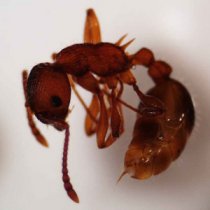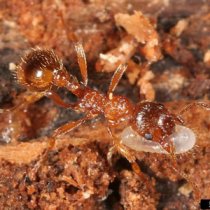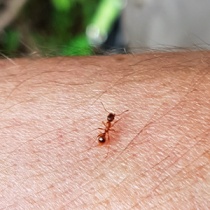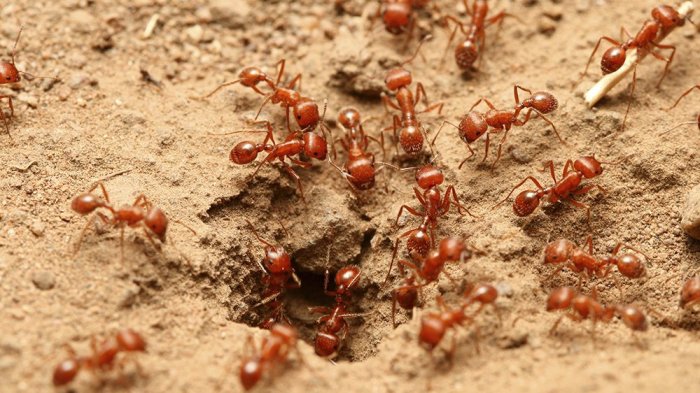European Fire Ant (Myrmica rubra)
French common name: fourmi rouge

Photo: E. Groden, Univeristy of Maine

Photo: Gary Alpert, Bugwood.org
Order: Hymenoptera
Family: Formicidae
Genus: Myrmica
Species: Rubra
Did you know? European fire ant queens can live up to 7 years. A queen might leave her colony to start a new one nearby, in a process known as “budding”. This aspect of the European fire ant’s ecology might enable its spread in North America.
The European fire ant is an invasive pest in North America whose native range is in Europe and northern Asia. It is named after the burning, itching sensation that its sting produces. Although the European fire ant has been present in North America for over one hundred years, it has only become pestiferous here in the last three decades (Groden et al., 2005, and Wetterer and Radchenko, 2011, as cited in Dunphy, 2016).
General Information
The European fire ant can appear red or light brown and is 4-5 millimeters in length (Okanagan Invasive Species Online). They usually attack in swarms, and will sting after their nests get disturbed. European fire ants can sting multiple times; this causes a burning, itching sensation, pustules, and in extremely rare (>1%) cases, anaphylaxis (Orkin Canada, 2018).
This ant species nests underground in lightly shaded areas with humid soil (Arevalo and Groden, 2007). Their nest mounds are not obvious, making them easy to step on and disturb. Nest densities are much higher in their established ranges in the U.S. than in their native range – up to 1.5 nests per square meter, compared with up to 0.3 nests per square meter in England (Groden et al., 2005).
Their high population and nest densities are facilitated by having multiple queens (polygyny) and multiple nests (polydomy) for each individual colony. In the European fire ant’s native range, colonies are highly mobile and may move throughout the summer.
New invasive infestations, however, seem to be caused by unintentional dispersal of infested soils by humans (Arevalo and Groden, 2007).
European fire ants form supercolonies (multiple nests and multiple queens in an area) in their native and introduced ranges, but we don’t know how they reproduce and spread in their introduced range (Dunphy, 2016).
In their native range, they likely spread by “budding”. This is where a mated queen and a group of worker ants split off from a colony and form a new one. They can also spread by sexual nuptial flights, where winged male ants fly off to mate with virgin queens from other colonies (Dunphy, 2016).
The formation of supercolonies, high nest density, and budding are all traits generally associated with invasive ant species (Dunphy, 2016).
Moist soil and wetlands are considered favourable habitat for European fire ants. A study sampling the ants in wetlands in the Credit River watershed in Ontario, examined the relationship between incidence and abundance of European fire ants and environmental factors, namely wetness, disturbance, and surrounding urban cover.
Ant incidence and ant abundance increased with surrounding human disturbance and amount of urban cover. The positive relationship between ant incidence and abundance, and higher urban cover allows for the hypothesis of the ants spreading through human transferring of infested plants, soils, and other biotic materials. The likelihood of this is higher in urban environments (Duthie et al., 2021).
The European fire ant’s presence in North America was first detected in the early 1900s in Massachusetts (Groden et al., 2005; Wetterer and Radchenko, 2011; Naumann and Higgins, 2015; and Chen and Adams, 2018, as cited in Duthie et al. 2021). It has now spread through the northeastern U.S. and Washington state, and southeastern Canada and British Columbia (Groden et al., 2005; Wetterer and Radchenko, 2011; Hicks, 2012; and Naumann and Higgins, 2015, as cited in Meadley et al., 2016).
The range of this ant species in North America appears to have expanded slowly. Many range extensions were only documented in an official capacity in the last 15 years. According to anecdotal evidence, it has been in Newfoundland for at least 45 years, but not collected until the year 2000. It was officially recognized in the province in 2010 (Hicks, 2012, as cited in Hicks et al., 2014).
It is possible for the European fire ant to have been introduced decades ago, with its population expanding only recently. It is not fully understood what barriers to population increase and spread may have lessened or been overcome, after decades of the European fire ant’s presence in North America (Hicks et al., 2014).
Based on mitochondrial DNA sequences from European fire ants collected in eastern Canada, the U.S., and Europe, Hicks et al. (2014) were able to identify possible sources from which the ant was introduced to Newfoundland. An origin point of Dorset County (in the southwest United Kingdom), is supported by historical records of commercial fishing traffic; the ant likely had been transferred through soil ballast that was unloaded in Newfoundland ports. The harbours of St. John’s and Carbonear/Harbour Grace have the highest abundance of introduced weed species from the United Kingdom (Cooper, 1981), and the European fire ant is found at these ports, as well as some of the oldest ports in Newfoundland.
One ant in Newfoundland was found to have the same haplotype as individuals found in Maine, U.S. The location in which this ant was found is directly adjacent to Fort Pepperall, a former American air force base that would have imported materials from the U.S. during the period it was active (1941-1960) (Hicks et al., 2014).
With their tendency to form supercolonies, European fire ants can take over habitats, negatively affecting native ant species and even altering native plant communities.
Naumann and Higgins (2015) conducted a study at four locations near the mouth of the Fraser River in southwestern British Columbia, comparing the presence and abundance of native ant species. At sites where the invasive ant was established, other native ant species were almost completely absent. The diversity of other ground-dwelling arthropod species was also consistently lower at sites with European fire ants.
Because many plants rely on seed dispersal by ants (which the ants rely on for food in a mutualist relationship), ants play a role in shaping plant community structure – ant species will differ in how far and in what environment they secondarily displace the seeds after initially bringing them to their nests (Dunphy, 2016).
In an outdoor experimental system mimicking the natural environment, Dunphy (2016) noticed that European fire ants better promoted the spread of invasive plant species, compared to native ant species, which were better at dispersing native plants.
 High densities of European fire ant nests can render a small area (like a park, garden, yard, or even golf course) unusable due to the risk of stepping on an ant nest and being swarmed. Pets and humans alike can get stung.
High densities of European fire ant nests can render a small area (like a park, garden, yard, or even golf course) unusable due to the risk of stepping on an ant nest and being swarmed. Pets and humans alike can get stung.
A report prepared by Robinson et al. (2013) estimated that the maximum cost that could be incurred from European fire ant damages at over $1 million if they were to occupy their full potential range in British Columbia. Treatment costs for household lawns and gardens would account for most of the damage, followed by the same for golf courses.
Signs of Infestation
Nests don’t usually form an obvious mound, and can be located under objects like wood piles, stones, and lawn ornaments (Okanagan Invasive Species Online). You may have European fire ants in your yard or garden if:
1) Your yard/garden has favourable habitat conditions, i.e., objects or piles on the ground that trap heat and moisture.

Image: modernpest.com
2) You live in a high-risk area.
3) Your neighbours have confirmed infestations.
4) You were stung by a swarm of red ants and experienced a burning, itching sensation.
European fire ants can be confused with other ant species, including ones that swarm and sting. You should always confirm an identification before seeking treatment.
Confirm the identification of European fire ants by safely collecting a sample and mailing it to a laboratory. Ants are less likely to sting on a cool morning. Wear personal protective clothing and set out apple slices to bait the ants. In an hour, check the apple slices for infestation. Pick up a slice with ants, place it into a container, and freeze overnight (Metro Vancouver and the Invasive Species Council of Metro Vancouver, 2019).
Management
European fire ants can be prevented from establishing and spreading in your yard or garden by minimizing watering and removing objects or piles from the ground that can trap heat and moisture. If you have an ant infestation, avoid moving soil or mulch from infested areas (Okanagan Invasive Species Online). Confirm the identification of European fire ants (refer to above) and report a known infestation by emailing info@invasivespeciescentre.ca.
It is recommended when working to control a suspected European fire ant infestation, to protect your skin by wearing gloves and closed-toed shoes or rainboots with pants tucked into socks. Using an insecticide is the best method of control or eradication if the total infested area is small enough and all nests are targeted (Metro Vancouver and the Invasive Species Council of Metro Vancouver, 2019). Check your local insecticide bylaws before proceeding – you will likely need a licensed professional to apply insecticide.
Baiting using 2% boric acid in a sugar solution, or altering the infested landscape (by removing rocks, logs, debris piles, etc.), can help contain an infestation and reduce population density, but will never eradicate the ants (Metro Vancouver and the Invasive Species Council of Metro Vancouver, 2019). Digging and torching infested soil is not recommended (Metro Vancouver and the Invasive Species Council of Metro Vancouver, 2019).
In non-residential spaces, it has been suggested that double-crested cormorants may have a negative impact on European fire ant presence. When cormorants nest in trees, their defecation alters soil chemistry, killing the trees. Gupta et al. (2018) found that European fire ant abundance was higher in healthy forests, and ant nest density did not change in healthy forests between study years. However, there were no ant nests in fields or dying forests, and in one location that changed over the course of the study period to a dying forest, ant abundance and nest density decreased.
This suggests that nesting double-crested cormorants have a negative impact on European fire ant presence. Reducing or eliminating European fire ants in these areas could benefit other ground-nesting birds that use deforested habitats.
References
Arevalo, H.A., and Groden, E. (2019). European fire ant – Myrmica rubra (Linnaeus). Ufl.edu.
Okanagan Invasive Species Online. European Fire Ant. (2021). OISO. Retrieved September 24, 2021.
Orkin Canada. What To Do When Bitten By A Fire Ant. (2018, October 15). Orkin.
Timms, L., Duthie, C., & Fraser, G. (2021). The European fire ant, Myrmica rubra (Linnaeus) (Hymenoptera: Formicidae), in the Credit River watershed. The Journal of the Entomological Society of Ontario, 152, 15–28.
